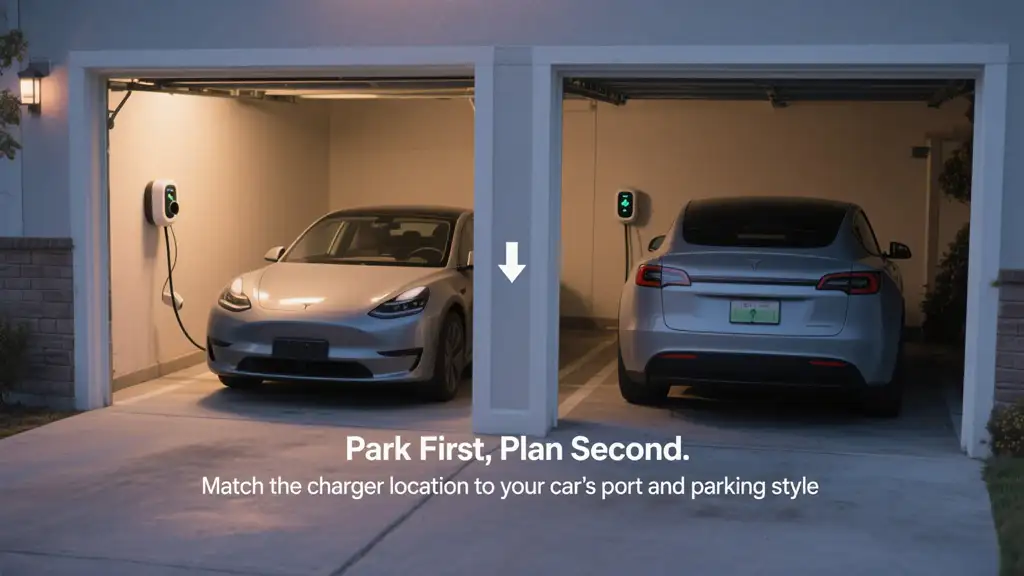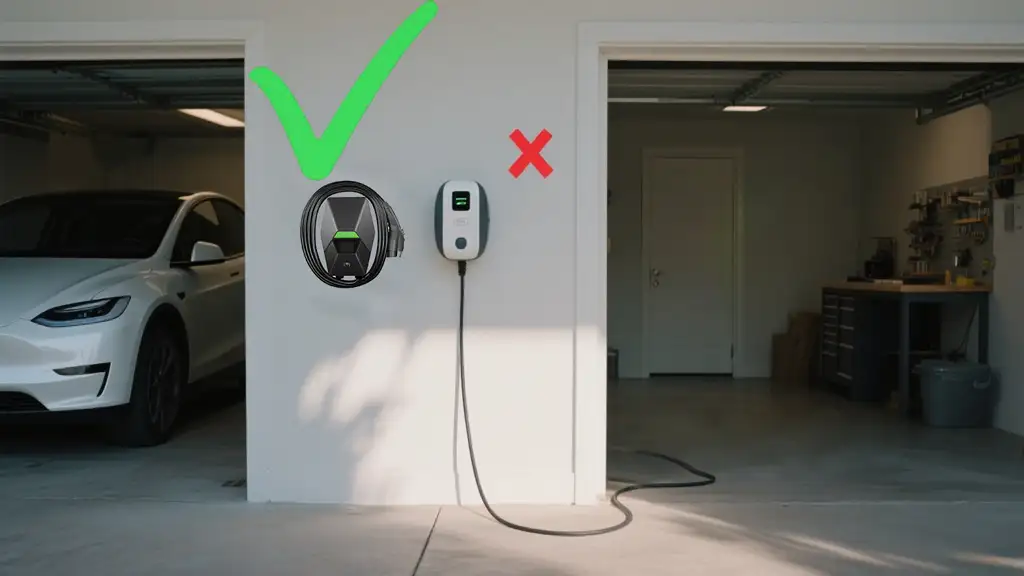Welcome to the electric vehicle family! You’ve made a great choice for your wallet and the planet. Now comes the next exciting step: setting up your home charging station. You’re probably wondering about the best location for an EV charger in your garage. This decision is more important than you might think.
Choosing the right spot isn’t just about convenience. A smart placement can save you thousands of dollars on installation, boost your home’s safety, and make your daily charging routine effortless. A poor choice can lead to hidden costs, daily annoyances, and even safety hazards.
We manufacture EV chargers every day. We know them inside and out. In this guide, we’ll share crucial insights that many electricians and online articles miss. We’ll walk you through everything you need to know about installing an EV charger in your garage, ensuring you get it right the first time.
Before you get creative, there are three basic rules you must follow. Getting these right forms the foundation of a successful installation. These rules balance cost, convenience, and pure, simple practicality.
Your home’s electrical panel (or breaker box) is the heart of your electrical system. This is where your new charger will get its power. The closer your EV charger in the garage is to the panel, the shorter the wiring run will be. This directly impacts your bottom line.
A shorter run requires less of the expensive, heavy-gauge copper wire needed for a high-power Level 2 charger. It also means less labor time for the electrician. According to the U.S. Department of Energy, the cost of installing an EV charger in a garage can vary widely based on the distance from the panel. A short, straightforward installation might cost a few hundred dollars, while a long, complex one can exceed $2,000.
Key Takeaway: Every foot of distance between your panel and your charger adds to the EV Charging Station Cost. Measure the distance and discuss the most direct wiring path with your electrician.
This may sound obvious, but it’s a common mistake. Before you drill any holes, park your car in its usual spot. Where is the charge port located? Some are on the front fender, some on the rear quarter panel, and others are near the nose or tail. Your charger should be located so the cable can easily reach the port.
Consider your daily routine. Do you typically back into the garage or pull in straight? The ideal location for the EV charger in your garage will change based on your parking habit. You don’t want to be stretching the cable to its limit or walking around the car every single day.

Standard EV charger cables are typically 18 to 25 feet long (about 5.5 to 7.5 meters). This seems like a lot, but you need to account for the path the cable takes. It has to go up from the charger, across the wall, and down to your car’s port without being too taut.
A longer cable provides more flexibility. It allows you to park slightly off-center without issue. More importantly, it can potentially reach the second bay in your garage. This is incredibly useful if a guest needs a charge or if you’re thinking about a second EV in the future. Always opt for a charger with a generous cable length.
With the fundamentals covered, let’s move on to the expert strategies. These are the details that separate a basic installation from a truly intelligent, future-proof setup. This is where you can leverage modern technology and smart planning.
The number of families with multiple EVs is growing rapidly. When installing an EV charger in your garage today, think about tomorrow. Will your partner or kids also be driving an EV in a few years?
Instead of installing a second, dedicated circuit later (which is expensive), consider two options. First, place your current charger in a central location where its cable can reach both parking spots. Second, look into smart chargers that support “Power Sharing” or “Load Sharing.” This feature allows two chargers to share a single circuit, intelligently balancing the power between them. This is a far more elegant and cost-effective solution for a multi-EV home.
Most modern chargers are “smart” devices. They connect to your home Wi-Fi to offer amazing benefits, like scheduling your charging for off-peak hours when electricity is cheapest, tracking your energy use, and receiving important software updates. However, these features are useless if the charger can’t get a stable Wi-Fi signal.
Garages are notorious for being Wi-Fi dead zones. Before you decide on a final location, take your smartphone to the proposed spot and run a speed test. Ensure you have at least two bars of stable Wi-Fi. If not, you may need to move the charger closer to the house or install a simple Wi-Fi extender. Don’t let a poor signal turn your smart charger into a dumb one.
Your garage isn’t just a place to park. It’s often a workshop, a storage area, and a major entry point to your home. When planning your garage ev charger placement, think about your daily movements. This is a key part of effective ev charging station design.
Avoid installing the charger directly in a path you walk every day. Don’t place it where it could be blocked by lawn equipment or where a car door could slam into it. The charging cable should not create a tripping hazard. A well-placed charger integrates seamlessly into your life, while a poorly placed one is a constant, minor annoyance.

Your EV is a piece of modern technology. Your charging station should reflect that. A dangling cable on the floor looks messy and can be a safety hazard. A clean, organized setup not only looks better but also protects your investment.
Consider investing in cable management accessories. A simple wall-mounted holster and plug dock keeps everything neat. For a premium setup, a ceiling-mounted cable retractor can keep the cable completely off the floor. Thinking about these small details transforms your EV charger in the garage from a simple utility into a sleek, integrated part of your modern home.
As people who design and build these devices, we consider factors that are critical for long-term performance and safety. Here’s what we think about when we picture our products in your garage.
EV chargers have a NEMA (National Electrical Manufacturers Association) rating that indicates their resistance to environmental factors. Most home chargers are NEMA 3R or NEMA 4. A NEMA 4 rating, for instance, means it’s watertight and can withstand a direct blast from a hose.
Even though your garage is indoors, consider potential water sources. Is it near a hot water heater, a utility sink, or a spot where you wash your car? The National Fire Protection Association (NFPA) provides guidelines for safe installation. Placing your charger away from any potential spray or moisture will ensure its longevity and safety, regardless of its NEMA rating. It’s also important to understand how EV Charging Stations Work electrically to appreciate these safety ratings.
Charging your EV generates heat, both in the car’s battery and in the charger itself. Our chargers are designed to dissipate this heat safely. However, you can help it perform at its best. Avoid installing it in a cramped, unventilated closet or a tight corner surrounded by clutter. A little bit of open space around the unit allows for natural air convection, keeping the electronics cool and running efficiently for years.
The type of charger you choose influences your placement decision. It’s helpful to understand how Level 1, Level 2, and DC fast chargers differ. For home use, you’ll mainly be choosing between Level 1 and Level 2. The debate between AC vs DC Chargers is also relevant, though most home units are AC.
| Consideration | Level 1 Charger (120V) | Level 2 Charger (240V) |
|---|---|---|
| Power Source | Standard wall outlet | Requires a new, dedicated 240V circuit |
| Installation | Plug-and-play | Professional installation required |
| Placement | Flexible, anywhere with an outlet | Less flexible, tied to 240V circuit location |
| Cost Impact | Minimal | Placement heavily impacts installation cost |
| Best For | Renters, infrequent drivers, plug-in hybrids | Most EV owners, daily charging |
Ultimately, there are many different types of EV chargers available, but a hardwired Level 2 charger is the most common and recommended solution for a permanent EV charger in the garage.
Use this quick checklist to review your plan before you call the electrician.
Choosing the best location for an EV charger in your garage is a one-time decision that pays dividends for years. By balancing the core principles of cost and convenience with forward-thinking strategies like future-proofing and smart home integration, you create a setup that is safe, efficient, and a pleasure to use.
You are now equipped with the knowledge to make an informed decision. You can confidently talk to your electrician, plan your installation, and look forward to years of easy, reliable home charging.
Ready to find the perfect charging station for your well-planned location? Explore our full range of smart, garage-ready EV chargers designed with all these best practices in mind.
Authoritative Sources
Size detaylı teknik bilgi ve fiyat teklifi göndereceğiz!